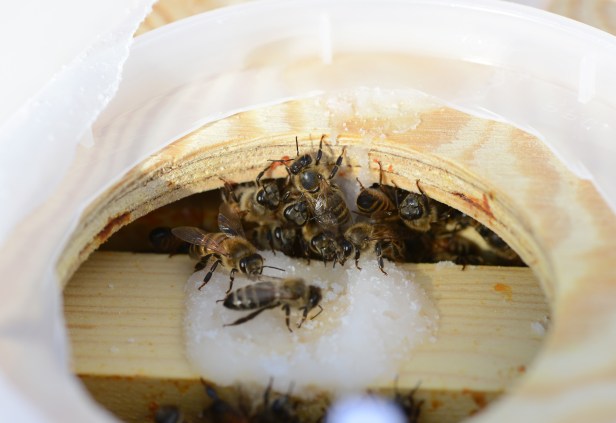Mission Accomplished
It’s mid February and mounds of snow are piled up all over the place, the residue of blizzard ‘Nemo’. I have no idea how the bees are doing inside the hive at this point. After each snowstorm I make sure that snow or other debris doesn’t block the hive’s entrances, both upper and lower. Aside from checking the entrances I also look for:
- Dead bees. Dead bees in front of the hive or on the snow nearby indicate that there are still bees, alive and well, in the hive. I’ve seen a few of them after each snowfall. I’ve never been so happy to see dead bees until this winter. One day I even saw an undertaker bee taking a body out.
- Varroa mites (Varroosis). Though I don’t treat my bees for Varroa mites, I check for it weekly just to keep a record. A corrugated foam sheet is inserted under the screen bottom board to make it easier to do the count. Not many mites so far, actually way below the maximum allowed. According to Beekeeper’s Handbook by Diana Sammataro & Alphonse Avitabile, more than 50 mites a day is considered high (amount of mites divided by amount of days the sheet was under the board)
- Wax residue. Tiny wax particles on the corrugated foam sheets under the bottom board is a sign that new cells were uncapped either for food or a new generation and there were some pale brown wax bits every time I checked.
That’s all I know from observation outside the hive. It seems fine, but I don’t know if they will have enough food to last until they can forage again.
One blogger, mylatinnotebook, has recommended that I feed bees fondant. Aside from leaving them a lot of honey, I also fed them a few gallons of sugar syrup before I closed the hive in autumn. But, as a newbie, I am willing to follow all recommendations I get as long as it doesn’t involve feeding them chemicals.
I made four packs of fondant over a week ago but the weather has been too cold to open the hive and feed the bees until today. The hive shouldn’t be opened for feeding if the temperature is below 40°F, or with rain or high wind. Today is 42°F, sunny with a little bit of wind so I cracked open the roof to peek in.
I took one pack of fondant out of the freezer and let it warm up a little bit. It wouldn’t stay solid. It softened to a thick syrup first and then started to stiffen up again. I couldn’t put it directly on the frames so I put it on the winter cover and fold the wax paper under to make a border. I checked the foam sheet 20 minutes later and saw some fondant on the sheet so I opened the hive again and put a plastic lid as a ring around the feeding hole to prevent more of it running out through the frames.
Opening the hive the second time, I found the bees were eating the dried fondant that dripped on the frame and some of them came up to eat on the inner cover. There were also uncapped honey frames present. I insulated the hive enough and the daytime temperature in the next couple of days will be around 40°F they should be able to come up to the inner cover.

They looked happy (as much as you can tell from a bee) and liked the fondant even though it may not have been up to ‘bee’ standards. I’ll have to practice making it, maybe with a different recipe.
There is still a month or so of winter left here but the bees have survived through hurricane ‘Sandy’, blizzard ‘Nemo’, and single digit temperatures with wind factors below 0°F, so they most likely will pull through this winter.
Let’s see how they are when I feed them next time.


You’ve taken such good care of the bees–I think they do look happy! Never realized the many layers involved in beekeeping.
Happy Darwin Day. In honor of Darwin Day I heard a talk tonight on bird signaling at the local arboretum that was pretty engaging.
I still have a lot to learn about beekeeping, but so far it’s been fun. The more I learn about bees the more I respect them and am fascinated by them. Aside from adding another hive this spring, I’m looking for more plants to add to our garden for them. It has turned out to be one of the best, most fun investments I have ever made.
Happy Darwin Day to you too. I know it’s a relatively new unofficial holiday but he’s long overdue for recognition. Thank you.
The fondant is good advice. My bees have been slowly munching their way through theirs over the winter. You may find when it gets to late February/March that it suddenly all gets gobbled up as the colony starts gearing up for spring, then you can put another lot on.
Thank you for your advice. It’s good to know. I’ll have to figure out how to make a better fondant.